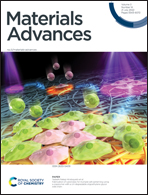The importance of structure property relationship for the designing of biomaterials using liquid crystal elastomers
Abstract
Regenerative medicine (RM) and tissue engineering (TE) have been at the forefront of the pursuit for repairing, regenerating, restoring diseased or damaged tissues or organs, and restoring their functions. The combined efforts within RM and TE had made it possible to increase the choice of biomaterials created while improving their final properties, study their processes/technologies to engineer scaffolds, and study scaffold-tissue behaviour. The advancement of the RM and TE interdisciplinary areas are fundamentally connected with the success of innovative biomaterials. In short, the success of RM and TE is contingent to biomaterials. To this end, the search for interactive biomaterial-scaffold-host systems led us to use liquid crystal elastomers (LCEs) as biomaterials due to their exceptional intrinsic anisotropy, mechanical properties, and shape actuation. The development of LCEs as biomaterials has been motivated by the chemistries for biocompatibility, easy processing, mechanical studies, and recently 3D printing. In our continuing pursuit to use LCEs as biomaterials we have carefully considered the chemistry and processability overall, while also refining our LCEs to fit precise needs of cells specifically to their size, mechanical needs, and time for growth and regeneration.

- This article is part of the themed collections: Editor’s Choice: Advances and New Avenues in Liquid Crystal Science and Recent Review Articles


 Please wait while we load your content...
Please wait while we load your content...